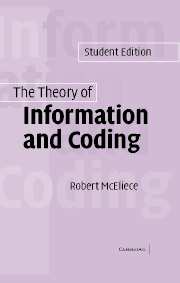Book contents
- Frontmatter
- Contents
- Editor's statement
- Section editor's foreword
- Preface to the first edition
- Preface to the second edition
- Introduction
- Part one Information theory
- Part two Coding theory
- 7 Linear codes
- 8 Cyclic codes
- 9 BCH, Reed–Solomon, and related codes
- 10 Convolutional codes
- 11 Variable-length source coding
- 12 Survey of advanced topics for Part two
- Appendices
- References
- Index of Theorems
- Index
12 - Survey of advanced topics for Part two
from Part two - Coding theory
Published online by Cambridge University Press: 05 June 2012
- Frontmatter
- Contents
- Editor's statement
- Section editor's foreword
- Preface to the first edition
- Preface to the second edition
- Introduction
- Part one Information theory
- Part two Coding theory
- 7 Linear codes
- 8 Cyclic codes
- 9 BCH, Reed–Solomon, and related codes
- 10 Convolutional codes
- 11 Variable-length source coding
- 12 Survey of advanced topics for Part two
- Appendices
- References
- Index of Theorems
- Index
Summary
Introduction
This chapter serves the same function for Part two as Chapter 6 served for Part one, that is, it summarizes some of the most important results in coding theory which have not been treated in Chapters 7–11. In Sections 12.2, 12.3, and 12.4 we treat channel coding (block codes, convolutional codes, and a comparison of the two). Finally in Section 12.5 we discuss source coding.
Block codes
The theory of block codes is older and richer than the theory of convolutional codes, and so this section is much longer than Section 12.3. (This imbalance does not apply to practical applications, however; see Section 12.4.) In order to give this section some semblance of organization, we shall classify the results to be cited according to Berlekamp's list of the three major problems of coding theory:
How good are the best codes?
How can we design good codes?
How can we decode such codes?
• How good are the best codes? One of the earliest problems which arose in coding theory was that of finding perfect codes. If we view a code of length n over the finite field Fq as a subset {x1, x2, …, xM} of the vector space Vn(Fq), the code is said to be perfect (or close packed) if for some integer e, the Hamming spheres of radius e around the M codewords completely fill Vn(Fq) without overlap.
Information
- Type
- Chapter
- Information
- The Theory of Information and CodingStudent Edition, pp. 347 - 365Publisher: Cambridge University PressPrint publication year: 2004
